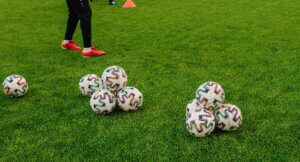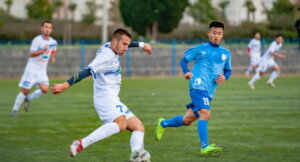Football / Soccer




Soccer, also known as football, is a popular sport played worldwide. It is believed to have originated in ancient times, with various versions of the game played by different cultures throughout history.
Soccer, also known as football, is a popular sport played worldwide. It is believed to have originated in ancient times, with various versions of the game played by different cultures throughout history.
Soccer, also known as football, is a popular sport played worldwide. It is believed to have originated in ancient times, with various versions of the game played by different cultures throughout history.
Soccer, also known as football, is a popular sport played worldwide. It is believed to have originated in ancient times, with various versions of the game played by different cultures throughout history.
Soccer, also known as football, is a popular sport played worldwide. It is believed to have originated in ancient times, with various versions of the game played by different cultures throughout history.
Soccer, also known as football, is a popular sport played worldwide. It is believed to have originated in ancient times, with various versions of the game played by different cultures throughout history.
Soccer, also known as football, is a popular sport played worldwide. It is believed to have originated in ancient times, with various versions of the game played by different cultures throughout history.
Soccer, also known as football, is a popular sport played worldwide. It is believed to have originated in ancient times, with various versions of the game played by different cultures throughout history.
Soccer, also known as football, is a popular sport played worldwide. It is believed to have originated in ancient times, with various versions of the game played by different cultures throughout history.
Soccer, also known as football, is a popular sport played worldwide. It is believed to have originated in ancient times, with various versions of the game played by different cultures throughout history.
Soccer, also known as football, is a popular sport played worldwide. It is believed to have originated in ancient times, with various versions of the game played by different cultures throughout history.
The ancient Greeks and Romans played a game called harpastum, which involved two teams trying to get a ball across a goal line. In the Middle Ages, a game called “mob football” was played in England, where teams from different towns would compete to get a ball to their respective goals.
However, it wasn’t until the mid-19th century that modern soccer began to take shape. The first official soccer match was played in 1863 in London, England, with a set of standardized rules established by the newly formed Football Association.
From there, soccer quickly spread throughout Europe and South America, becoming a popular pastime in countries such as Brazil, Argentina, and Spain. In 1904, FIFA (Fédération Internationale de Football Association) was formed to govern international soccer, and the first World Cup was held in 1930.
Today, soccer is the most widely played and watched sport in the world, with an estimated 3.5 billion fans and over 250 million players in over 200 countries. The sport has evolved greatly over the years, with changes to rules, tactics, and equipment.
One of the most significant changes in soccer history was the introduction of the offside rule in the late 1800s. This rule prohibits a player from being involved in active play if they are closer to the opposing team’s goal than both the ball and the second-to-last defender.
The development of the modern soccer ball has also had a significant impact on the game. In the past, soccer balls were made of leather and would absorb water, making them heavy and difficult to control in wet conditions. Today’s soccer balls are made of synthetic materials and are much lighter and easier to maneuver.
Tactics and strategies have also evolved over time, with coaches and players constantly innovating to gain an edge over their opponents. The introduction of formations, such as the 4-4-2 and 3-5-2, have allowed teams to adapt to different playing styles and opponent strengths.
Soccer has also had a significant impact on culture and society. In many countries, soccer is more than just a sport – it is a way of life. Fans are fiercely loyal to their teams, and soccer has been the source of countless cultural traditions and rituals.
The sport has also been used as a tool for social change and activism. In apartheid-era South Africa, soccer was used to promote racial equality and was a source of unity for people of different backgrounds. Today, soccer is often used to promote education, health, and social justice initiatives around the world.
The Asian Football Confederation (AFC) is the governing body of soccer in Asia and Australia. The AFC oversees the development and growth of the game in its 47 member associations, as well as organizes and manages continental competitions and events, such as the AFC Asian Cup and the AFC Champions League. The AFC also represents the interests and aspirations of its members in the global soccer community.
The Asian Football Confederation (AFC) has 47 member associations split into five regions
- West Asia (12): Bahrain, Iraq, Jordan, Kuwait, Lebanon, Oman, Palestine, Qatar, Saudi Arabia, Syria, United Arab Emirates, Yemen
- Central Asia (6): Afghanistan, Iran, Kyrgyz Republic, Tajikistan, Turkmenistan, Uzbekistan
- South Asia (7): Bangladesh, Bhutan, India, Maldives, Nepal, Pakistan, Sri Lanka
- East Asia (10): China PR, Chinese Taipei, DPR Korea, Guam, Hong Kong, Japan, Korea Republic, Macau (associate member), Mongolia, Philippines
- Southeast Asia (12): Australia, Brunei Darussalam (associate member), Cambodia, Indonesia, Laos, Malaysia, Myanmar, Singapore, Thailand, Timor-Leste (associate member), Vietnam
More>>
The ASEAN Football Federation (AFF) is an organization that promotes and develops the sport of soccer in Southeast Asia. The AFF aims to enhance the quality and competitiveness of its member associations, as well as to foster cooperation and friendship among them. The AFF also organizes regional tournaments and events, such as the AFF Championship and the AFF Women’s Championship.
The ASEAN Football Federation (AFF) is an organisation within the AFC that focuses on Southeast Asia. It has 12 member associations
| Australia | Brunei Darussalam | Cambodia | Indonesia | Laos | Malaysia | Myanmar | Philippines | Singapore | Thailand |
| Timor-Leste | Vietnam |
CAFA = Central Asian Football Association (CAFA)
Central Asian Football Association, which is one of the five regional associations that govern football in Asia. It oversees football, futsal, and beach football in Central Asia, and has six member associations. CAFA was founded in 2015 with the support of the Asian Football Confederation (AFC) and aims to develop and strengthen the game of football in the region by raising the standards and creating more opportunities for its members. CAFA is currently based in Dushanbe, Tajikistan and has a president, a vice-president, a second vice-president, and a general secretary as its executive committee. CAFA also has representatives on the AFC executive committee and vice-presidency. CAFA organizes competitions between national teams, such as the CAFA Championship, the CAFA Nations Cup, the CAFA U17 Women’s Championship, the CAFA U20 Women’s Championship, and the CAFA U19 Futsal Championship. CAFA also conducts seminars and workshops for referees, coaches, and administrators.
The current member associations of CAFA are
| Afghanistan | Iran | Kyrgyzstan | Tajikistan | Turkmenistan | Uzbekistan |
As of January 2023, Iran is the highest-ranked CAFA team in the FIFA World Rankings at 24th place, followed by Uzbekistan at 66th place.
EAFF = East Asian Football Federation (EAFF)
East Asian Football Federation, which is one of the five regional associations that govern football in Asia. It oversees football, futsal, and beach football in East Asia, and has 10 member associations. EAFF was established in 2002 with the support of the Asian Football Confederation (AFC) and aims to develop and strengthen the game of football in the region by raising the standards and creating more opportunities for its members. EAFF is currently based in Hangzhou, China PR and has a president, a vice-president, a general secretary, and an executive committee. EAFF also has representatives on the AFC executive committee and vice-presidency. EAFF organizes competitions between national teams, such as the EAFF E-1 Football Championship, the AFF–EAFF Champions Trophy, the EAFF Futsal Championship, and the Youth Games. EAFF also conducts seminars and workshops for referees, coaches, and administrators. The current member associations of EAFF are
| China PR | Taiwan | Hong Kong | Macau | Mongolia | North Korea | South Korea | Northern Mariana Islands | Guam | Japan |
As of January 2023, Japan is the highest-ranked EAFF team in the FIFA World Rankings at 11th place, followed by South Korea at 25th place.
SAFF = South Asian Football Federation (SAFF)
South Asian Football Federation, which is one of the five regional associations that govern football in Asia. It oversees football, futsal, and beach football in South Asia, and has seven member associations.SAFF was established in 1997 with the support of the Asian Football Confederation (AFC) and aims to develop and strengthen the game of football in the region by raising the standards and creating more opportunities for its members. SAFF is currently based in Dhaka, Bangladesh and has a president, two vice-presidents, a general secretary, and an executive committee. SAFF also has a representative on the AFC executive committee. SAFF organizes competitions between national teams, such as the SAFF Championship, the SAFF Women’s Championship, the SAFF U-18 Championship, the SAFF U-15 Championship, and the SAFF U-18 Women’s Championship. SAFF also conducts seminars and workshops for referees, coaches, and administrators.
The current member associations of SAFF are
| Bangladesh | Bhutan | India | Maldives | Nepal | Pakistan | Sri Lanka |
As of January 2023, India is the highest-ranked SAFF team in the FIFA World Rankings at 97th place, followed by Maldives at 151st place.
WAFF = West Asian Football Federation (WAFF)
WAFF stands for West Asian Football Federation, which is one of the five regional associations that govern football in Asia. It oversees football, futsal, and beach football in West Asia, and has 12 member associations12. WAFF was founded in 2001 with the support of the Asian Football Confederation (AFC) and aims to develop and strengthen the game of football in the region by raising the standards and creating more opportunities for its members. WAFF is currently based in Amman, Jordan and has a president, a vice-president, a general secretary, and an executive committee. WAFF also has a representative on the AFC executive committee. WAFF organizes competitions between national teams, such as the WAFF Championship, the WAFF Women’s Championship, the WAFF U-18 Championship, the WAFF U-15 Championship, and the WAFF U-18 Women’s Championship. WAFF also conducts seminars and workshops for referees, coaches, and administrators. The current member associations of WAFF are
| Bahrain | Iraq | Jordan | Kuwait | Lebanon | Oman | Palestine | United Arab Emirates | Saudi Arabia | Qatar |
| Syria | Yemen |
As of January 2023, Iran is the highest-ranked WAFF team in the FIFA World Rankings at 21st place, followed by Qatar at 40th place.
FIFA = Federation internationale de football association (FIFA)
Federation internationale de football association, which is the international governing body of association football, beach soccer, and futsal. It was founded in 1904 by the national associations of Belgium, Denmark, France, Germany, the Netherlands, Spain, Sweden and Switzerland. Its headquarters are in Zürich, Switzerland, and it has 211 national associations as its members. FIFA is also a member of the International Olympic Committee and the International Football Association Board. FIFA organizes and promotes the major international tournaments of association football, such as the World Cup, the Women’s World Cup, the Club World Cup, and the Confederations Cup. FIFA also oversees the qualifying tournaments for these events, which are held within the six regional confederations: CAF (Africa), AFC (Asia and Australia), UEFA (Europe), CONCACAF (North & Central America and the Caribbean), OFC (Oceania) and CONMEBOL (South America). FIFA sets and enforces the rules of the game across all its competitions.
UEFA = Union of European Football Associations (UEFA)
The Union of European Football Associations (UEFA) is the governing body for football in Europe. It oversees and organizes various competitions, including the prestigious UEFA European Championship and the UEFA Champions League.
UEFA comprises member associations from different countries across Europe. Here is a list of countries that are members of UEFA:
| Albania | Andorra | Armenia | Austria | Azerbaijan | Belarus | Belgium | Bosnia and Herzegovina | Bulgaria | Croatia |
| Cyprus | Czech Republic | Denmark | England | Estonia | Faroe Islands | Finland | France | Georgia | Germany |
| Gibraltar | Greece | Hungary | Iceland | Ireland | Israel | Italy | Kazakhstan | Kosovo | Latvia |
| Liechtenstein | Lithuania | Luxembourg | Malta | Moldova | Montenegro | Netherlands | North Macedonia | Northern Ireland | Norway |
| Poland | Portugal | Romania | Russia | San Marino | Scotland | Serbia | Slovakia | Slovenia | Spain |
| Sweden | Switzerland | Turkey | Ukraine | Wales |
These countries collectively participate in UEFA competitions and contribute to the development and growth of football in Europe.
OFC = Oceania Football Confederation (OFC)
The Oceania Football Confederation (OFC) serves as the governing body for football in the Oceania region. Its primary goal is to oversee and promote the sport across its member associations, which include countries and territories in the Pacific Ocean area.
Countries and territories that are members of the Oceania Football Confederation:
| American Samoa | Cook Islands | Fiji | Kiribati | New Caledonia | New Zealand | Niue | Papua New Guinea | Samoa | Solomon Islands |
| Tahiti (French Polynesia) | Tonga | Tuvalu | Vanuatu |
These countries and territories actively participate in OFC competitions and work together to develop and enhance football in the region. The OFC organizes various tournaments, including the OFC Nations Cup and the OFC Champions League, providing platforms for teams and players to showcase their skills and compete at regional and international levels.
CAF = Confederation of African Football (CAF)
The Confederation of African Football (CAF) is the governing body for football in Africa. Its primary objective is to oversee and promote the sport across its member associations, which consist of countries from the African continent.
Countries that are members of the Confederation of African Football (CAF):
| Algeria | Angola | Benin | Botswana | Burkina Faso | Burundi | Cameroon | Cape Verde | Central African Republic |
| Chad | Comoros | Congo | Congo DR | Cote d’Ivoire (Ivory Coast) | Djibouti | Egypt | Equatorial Guinea | Eritrea | Eswatini (formerly Swaziland) |
| Ethiopia | Gabon | Gambia | Ghana | Guinea | Guinea-Bissau | Kenya | Lesotho | Liberia | Libya | Malawi |
| Madagascar | Mali | Mauritania | Mauritius | Morocco | Mozambique | Namibia | Niger | Nigeria | Rwanda | Sao Tome and Principe |
| Senegal | Seychelles | Sierra Leone | Somalia | South Africa | South Sudan | Sudan | Tanzania | Togo | Tunisia | Uganda |
| Zambia | Zimbabwe |
These countries participate in various CAF competitions, such as the Africa Cup of Nations and the CAF Champions League, to showcase their football prowess and compete for continental glory.
CONCACAF = Confederation of North, Central American and Caribbean Association Football (CONCACAF)
The Confederation of North, Central American and Caribbean Association Football (CONCACAF) serves as the governing body for football in the North, Central American, and Caribbean regions. It is responsible for overseeing and organizing football activities and competitions among its member associations.
Countries that are members of the Confederation of North, Central American and Caribbean Association Football (CONCACAF):
| Anguilla | Antigua and Barbuda | Aruba | Bahamas | Barbados | Belize | Bermuda | Bonaire | British Virgin Islands | Canada | Cayman Islands |
| Costa Rica | Cuba | Curacao | Dominica | Dominican Republic | El Salvador | French Guiana | Grenada | Guadeloupe | Guatemala | Guyana |
| Haiti | Honduras | Jamaica | Martinique | Mexico | Montserrat | Nicaragua | Panama | Puerto Rico | Saint Kitts and Nevis | Saint Lucia |
| Saint Martin | Saint Vincent and the Grenadines | Sint Maarten | Suriname | Trinidad and Tobago | Turks and Caicos Islands | United States | U.S. Virgin Islands |
These countries and territories actively participate in CONCACAF competitions, including the CONCACAF Gold Cup and the CONCACAF Champions League, showcasing their football skills and competing for regional supremacy.
CONMEBOL = Confederación Sudamericana de Fútbol (CONMEBOL)
The Confederacion Sudamericana de Futbol (CONMEBOL) is the governing body for football in South America. It is responsible for overseeing and organizing football activities and competitions among its member associations.
Here is a list of countries that are members of the Confederacion Sudamericana de Fútbol (CONMEBOL):
| Argentina | Bolivia | Brazil | Chile | Colombia | Ecuador | Paraguay | Peru | Uruguay | Venezuela |
These countries participate in various CONMEBOL competitions, including the Copa América and the Copa Libertadores, to showcase their football talent and compete for regional glory.
Bundesliga #13
Bundesliga #13
Bundesliga #13
Bundesliga #13
Manchester United #14
Manchester United #14
Manchester United #14
Manchester United #14
Liverpool #15
Liverpool #15
Liverpool #15
Liverpool #15
Best Football Club , UK, Europe, Middle East, Asia
England Germany France Spain Italy Portugal Netherlands Belgium Sweden Croatia
South Korea Japan China Uzbekistan
Argentina Brazil Mexico Uruguay Colombia
Best Football Club in Middle East
UAE Saudi Arab Qatar Oman
Nigeria Best Kayaking Training / Canoeing Training
Best Kayaking Time / Canoeing suitable time
To ensure a safe and enjoyable kayaking experience (Pros & Cons)















Best Football / Soccer Gear
FIFA World Cup: The FIFA World Cup is the most prestigious international football tournament. It is held every four years and features national teams from around the world competing for the title of world champions. The FIFA World Cup is open to teams from all continents, and countries from every corner of the globe have participated in the tournament over the years. Some of the prominent countries that have a rich history and strong presence in the FIFA World Cup include “Brazil, Germany, Italy, Argentina, France, England, Spain, Netherlands.”
UEFA European Championship: The UEFA European Championship, commonly referred to as the Euro, is a quadrennial tournament organized by the Union of European Football Associations (UEFA). It brings together national teams from European countries to compete for the championship.
Copa America: The Copa America is the oldest international continental football competition, featuring teams from South America. It is held every four years and showcases the top national teams from the region.
AFC Asian Cup: The AFC Asian Cup is the premier football tournament for national teams in Asia. It takes place every four years and determines the continental champion of Asia.
CONCACAF Gold Cup: The CONCACAF Gold Cup is a biennial tournament featuring national teams from North and Central America as well as the Caribbean. It crowns the regional champion of the CONCACAF region.
CAF Africa Cup of Nations: The Africa Cup of Nations is the primary international football competition for African national teams. It is held every two years and determines the continental champion of Africa.
FIFA Club World Cup: The FIFA Club World Cup brings together the champions of each continent’s club competitions to compete for the title of world club champions. It is held annually.
Domestic Cups: In addition to international competitions, each country has its own domestic cups. These cups, such as the FA Cup in England, the DFB-Pokal in Germany, or the Copa del Rey in Spain, involve teams from various divisions competing for domestic glory.
Football / Soccer gear is the equipment and clothing that soccer players use to play the sport. It includes a range of items that are designed to enhance performance and protect the player from injury. In this article, we will discuss the various types of soccer gear, their purpose, and how to choose the best gear for your needs.
The ball used in football is typically made of leather, a material known for its durability and performance. Leather footballs have been a traditional choice for many years due to their excellent touch and feel.
Leather footballs are commonly made from cowhide or kangaroo leather. Cowhide leather is widely used and offers good durability and resistance to wear. Kangaroo leather, on the other hand, is known for its softness and flexibility, providing a superior touch and control. Both types of leather are carefully selected and processed to ensure optimal performance on the field.
The manufacturing process of leather footballs involves cutting and stitching together multiple panels to form the ball’s spherical shape. The panels are often hexagonal or pentagonal in design, creating the iconic pattern seen on most footballs. The leather panels are carefully stitched together using strong threads to ensure durability and maintain the ball’s shape during play.
It’s important to note that not all footballs are made exclusively from leather. Synthetic materials, such as polyurethane (PU) or polyvinyl chloride (PVC), are also commonly used to manufacture footballs. These synthetic materials offer advantages such as increased durability, water resistance, and consistency in performance. Synthetic footballs are often preferred for recreational play and training purposes.
When choosing a football, it’s essential to consider factors like playing conditions, intended use, and personal preferences. Leather footballs provide a classic and premium feel, but synthetic options can offer added benefits in terms of durability and performance in various weather conditions.
Taking proper care of a leather football is crucial to maintain its quality and longevity. Regular cleaning and conditioning can help preserve the leather’s suppleness and prevent cracking or deterioration.
Soccer cleats are arguably the most important piece of gear that a soccer player can own. They are designed to provide traction on the field, allowing players to make sharp turns, sudden stops, and quick movements. Soccer cleats come in a variety of styles, with different studs and configurations to suit different types of playing surfaces. When selecting soccer cleats, it is important to consider the playing surface, the player’s position, and their individual needs.
Shin Guards:
Shin guards are worn to protect the lower legs from injury during play. They are typically made of plastic or foam and are designed to fit snugly against the player’s shin. Shin guards come in a variety of sizes and styles to suit different ages and levels of play. It is important to choose shin guards that fit properly and provide adequate protection.
Soccer Socks:
Soccer socks are designed to be worn over the player’s shin guards. They come in a variety of styles and colors and are made of materials that are breathable and moisture-wicking. Soccer socks should fit snugly but not be too tight, as this can cause discomfort and restrict circulation.
Soccer Shorts:
Soccer shorts are typically made of lightweight, breathable material and are designed to allow freedom of movement. They come in a variety of styles and colors and should fit snugly but not be too tight.
Soccer Jerseys:
Soccer jerseys are the shirts worn by players during games. They are typically made of lightweight, breathable material and feature the team’s colors and logo. Soccer jerseys should fit snugly but not be too tight, as this can restrict movement and cause discomfort.
Goalkeeper Gear:
Goalkeepers have specialized gear that is designed to protect them from injury during play. This gear includes gloves, which are used to grip the ball and protect the hands, and padded shorts, which provide additional protection when diving and sliding.
Training Gear:
In addition to game gear, soccer players often use training gear to improve their skills and fitness. This gear includes training cones, agility ladders, and resistance bands, among other items. It is important to choose training gear that is appropriate for the player’s age and level of play.
Choosing the Right Soccer Gear:
When selecting soccer gear, it is important to consider the player’s individual needs and preferences. Factors to consider include the playing surface, the player’s position, their level of play, and their budget. It is also important to choose gear that is comfortable and fits properly, as ill-fitting gear can cause discomfort and restrict movement.
| For Mobile Gaming, Nintendo Switch, Xbox One, PS4 & PS5 | ||
| Ear Gaming Headset | Turtle Beach Battle Buds | Best Price >> |
| JBL Quantum 100 Wired Over-Ear Gaming Headset with Boom Mic, PC and Console Compatible, in White | Leather / Over Ear | Best Price >> |
| JBL Quantum 300 Wired Over-Ear Gaming Headsets with Microphone, PC and Console Compatible, in Black | Leather / Over Ear | Best Price >> |
| JBL Quantum 100 Wired Over-Ear Gaming Headset with Boom Mic, PC and Console Compatible, in Blue | Leather / Over Ear | Best Price >> |
The innovative new PS5 controller DualSense wireless controller highly immersive gaming experience, built-in microphone and create button, all integrated into an iconic, comfortable design, you would love to discover.
| Controller: | ||
| PlayStation 5 DualSense Wireless Controller, highly immersive gaming experience. | Best Price >> | |
| PlayStation 5 PULSE 3D Wireless Headset, dual noise-cancelling microphones,fine-tuned for 3D Audio on PS5 consoles. | Best Price >> | |
- Long awaited Playstation 5
- A revolutionary piece of technology
- It has changed the Gaming world
- It comes with Ultra high speed SSD
- Long awaited Playstation 5
- It comes with Ultra high speed SSD
- Velit esse cillum dolore eu fugiat nulla pariatur
- A revolutionary piece of technology
- A revolutionary piece of technology
- A revolutionary piece of technology
- It comes with Ultra high speed SSD
- Ullamco laboris nisi ut aliquip ex ea commodo
- Duis aute irure dolor in reprehenderit in voluptate
- It comes with Ultra high speed SSD
Football, the world’s most popular sport, has undergone significant transformations in recent years, both on and off the field. From the rise of tactical innovations to the influence of technology and the changing dynamics of fan engagement, football today is a dynamic and ever-evolving phenomenon. In this article, we will delve into the key aspects that shape the modern landscape of football and explore the factors contributing to its continued global appeal.
Tactical Innovations and Strategic Approaches: In today’s football, tactical innovations play a pivotal role in shaping the game. Coaches and managers constantly seek new strategies to outsmart their opponents, with intricate formations, pressing styles, and positional play becoming prevalent. From the fluid attacking systems of tiki-taka to the high-intensity pressing tactics, teams are constantly adapting to gain a competitive edge.
Technological Advances: Technology has revolutionized football in various ways, enhancing the fairness and accuracy of the game. The introduction of goal-line technology has eliminated controversies regarding goal decisions, ensuring greater precision. Video Assistant Referee (VAR) technology has also been implemented in several leagues, allowing for more accurate offside calls and decisions involving penalties and red cards. These advancements have contributed to fairer outcomes and sparked debates among fans and experts alike.
Globalization and Cultural Exchange: Football has transcended borders, becoming a global phenomenon that unites people from diverse cultures and backgrounds. Players from different nations now compete in top leagues worldwide, enriching the game with their unique styles and techniques. The global reach of football has expanded, with international tournaments attracting massive audiences and showcasing the talents of players from all corners of the globe.
Fan Engagement and Digital Revolution: The digital revolution has transformed the way football is consumed and experienced by fans. Social media platforms provide a platform for instant reactions, discussions, and interactions between fans, players, and clubs. Fans can now access real-time updates, highlights, and exclusive content, enhancing their engagement with the sport. Additionally, virtual reality experiences and interactive applications have further immersed fans in the footballing world, providing a more immersive and interactive experience.
Social Impact and Responsibility: Football has recognized its influence and the role it can play in addressing social issues. Initiatives such as community outreach programs, campaigns against racism and discrimination, and environmental sustainability efforts have become integral to the footballing landscape. Players, clubs, and governing bodies actively promote inclusivity, diversity, and positive social change, leveraging the sport’s popularity to make a difference.
Football today represents more than just a game. It embodies the spirit of competition, unites people from diverse backgrounds, and reflects the ever-changing dynamics of our society. With tactical innovations, technological advancements, global fan engagement, and a growing sense of social responsibility, football continues to captivate and inspire millions across the world. As the sport evolves, it will undoubtedly witness further transformations, ensuring its enduring legacy for generations to come.
Trademark Disclaimer:
All trademarks, logos, and brand names are the property of their respective owners. All company, product, and service names used in this website are for identification purposes only. Use of these names trademarks, and brands, specifications do not imply endorsement.




